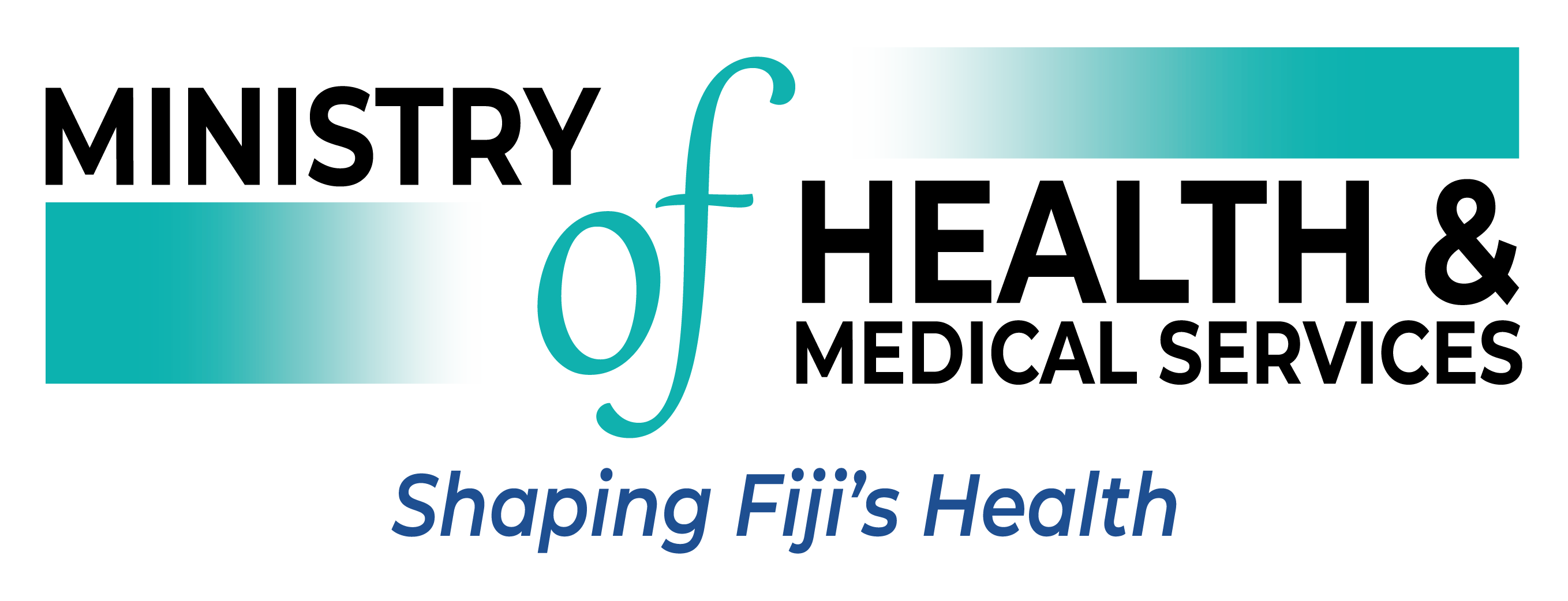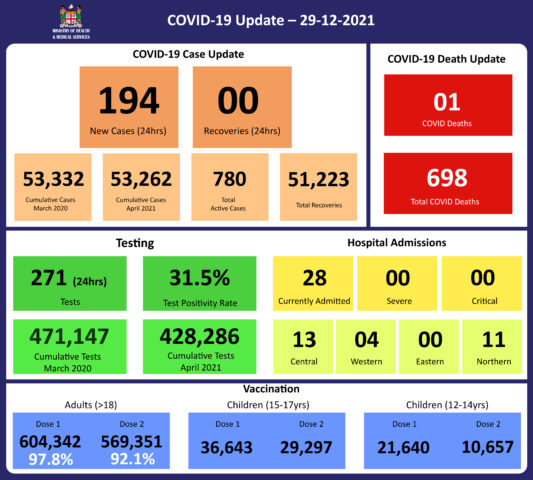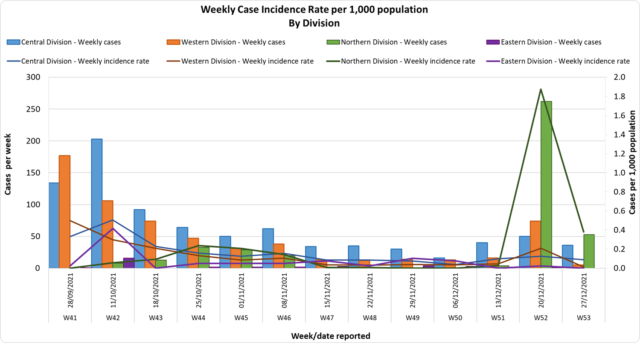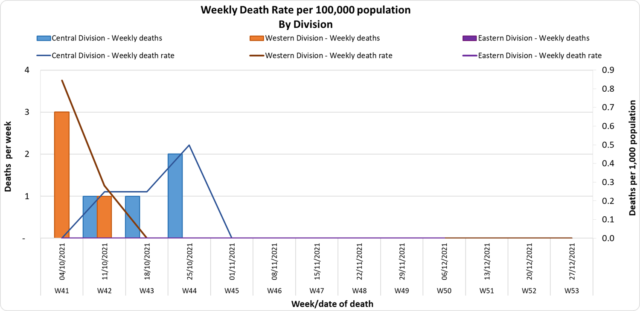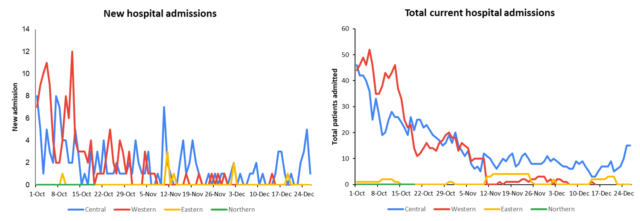COVID-19 Update 29-12-2021
COVID-19 Situation Update
Wednesday, 29th December
| Transmission Update:
In the past 7 days until 28/12/2021, 85 cases were recorded in the Central division, 74 new cases in the Western division, 1 new case in the Eastern Division, and 316 new cases in the Northern Division. The Central Division cases constitute 71% of the cumulative total cases nationally, with the Western division making up 27%, 1% in the Northern Division, and 1% in the Eastern Division. Since the last update, we have recorded 309 new cases of which 115 new cases were recorded on 28/12/2021 and 194 new cases in the last 24 hours ending at 8 am this morning. Of the 194 cases recorded in the last 24 hours, 136 cases were recorded in the Northern Division; 6 cases were recorded in the Western Division including 4 cases from border quarantine, 46 cases recorded in the Central Division, and 6 cases recorded in the Eastern Division. The national 7-day rolling average of cases as of 25th December is 10 daily cases. |
| Deaths:
This curve depicts the weekly death rate per 1,000 population by divisions since October 2021. Overall, the death rate graphs for the Central and Western Divisions indicate a sustained declining trend. The differences between the Central and Western are similar to the incidence of the weekly cases and are likely a reflection of vaccination levels, COVID mitigation measures, and differences in population density. There is one COVID-19 death to report. The COVID-19 death report is of a 62-year-old man from Tailevu who died at home with severe respiratory distress on 25/12/2021. He received the first dose of the COVID-19 vaccine on 14/04/2021 and his second dose on 23/07/2021. This means he was fully vaccinated. There have been 698 deaths due to COVID-19 in Fiji, with 696 of these deaths during the outbreak that started in April this year. Please note that due to the time required by clinical teams to investigate, classify and report deaths, a 4-day interval is given to calculate the 7 days rolling average of deaths, based on the date of death, to help ensure the data collected is complete before the average is reported. Therefore, as of December 25th, the national 7 days rolling average for COVID-19 deaths per day is 0.1. The 7 day rolling average for COVID-19 deaths per day in the Central Division is 0.1 and 0.0 in the Western and Eastern Division, with a case fatality rate of 1.32%. We have recorded 619 COVID-19 positive patients who died from serious medical conditions they had before they contracted COVID-19; these are not classified as COVID-19 deaths. |
| Hospitalisation:
The downward trend in both the new hospital admissions and total admissions in all hospitals admitting COVID-19 patients across the country is consistent with the cases and death trends. There are fluctuations in the new hospital admissions while total hospital admissions continue on a downward trend indicating a sustained positive response to COVID mitigation measures, Population density differences, and differential Vaccination rates. |
| Testing:
271 tests have been reported for December 28th, 2021. The 7-day daily test average is 301 tests per day or 0.3 tests per 1,000 population. The national 7-day average daily test positivity is 31.5%, which is above the WHO recommendation of 5%. The increased positivity rate is an indication of the continued surveillance undertaken in high-risk areas to detect cases early and mitigate the risks of community transmission. An increased positivity rate is also an indication of community transmission, indicating the need for heightened vigilance in all communities and adherence to COVID safe measures. |
Epidemic Outlook:
The Ministry of Health continues to monitor the outbreak using indicators such as daily case numbers, hospitalizations, test positivity, and deaths.
Occupancy rates in health facilities, the occupancy rate of ICU beds, death rates, and vaccination coverage are indicators to monitor our health response capacity. While we see a low trend across indicators from our health facilities with increasing vaccination coverage for adults, 15-17-year-olds, and 12-14-year-olds in Fiji the current escalation of cases indicates a need for increased readiness and response levels for severe disease and hospitalization.
COVID-19 cases are increasing rapidly globally and especially so in Australia, and the European and Americas region, and throughout Africa. The new highly transmissible variant Omicron is contributing significantly to this increase. As such, we anticipate an increasing number of cases from border quarantine facilities. Increased and sustained surveillance and testing at our borders, communities, and maritime islands are vital to monitor and detect COVID-19 cases for early intervention.
There is an increasing number of cases in all divisions which is anticipated to continue to increase, demanding ongoing surveillance for early intervention to mitigate COVID-19 risks.
Public Advisory:
The assessment of the Ministry of Health and Medical Services is that the current increase in COVID-19 cases represents the beginnings of the third wave of COVID-19 in Fiji. This may be a resurgence of the endemic Delta variant, however, we are also working on the assumption that the Omicron variant is already here, and is being transmitted within the community. We expect that genomic sequencing results of COVID-19 positive samples sent overseas will confirm this in due course. Should this wave be driven by the Omicron variant, based on what we are seeing overseas, we should expect a large number of cases, and we will also expect that infections will occur in vaccinated persons and those who have previously been infected with the Delta variant. However, it is important to remember that those who are vaccinated or had booster doses are far less likely to become sick enough to require hospitalization. The main focus of our vaccination program is preventing severe illness and death, which will also help to limit the strain on our medical services. Any additional protection that vaccines can provide against infection is an added bonus.
The three divisional hospitals are reporting an increase in positive cases admitted to the hospital, however, none of the cases so far are presenting with COVID-related medical problems. They are being admitted for other medical conditions and are testing positive during mandatory testing for all admissions to the hospital.
The overall goal of the MOHMS COVID-19 pandemic response and recovery has always been to minimize severe illness and deaths. This goal remains, along with reducing severe societal disruption as a result of the COVID-19 pandemic our priority is the promotion of individual COVID safe measures (vaccination, masking, physical distancing, avoiding crowds, hand hygiene), followed by settings-based measures (social gathering restrictions, indoor capacity restrictions, ventilation, and curfews). We intend to avoid population blanket measures, like lockdowns, as much as possible as, almost two years into the pandemic, such measures are damaging to our community on many different levels, and in our own recent experience, have limited value in controlling the spread of COVID-19 in Fiji. Also, with more than 91% of adults in Fiji vaccinated, plus added immunity expected due to the large number of people that were infected during the last wave on Viti Levu, we are no longer the COVID-naive population that we were before. The immunity that has been built through vaccination, and prior infection, is expected to have a significant impact on reducing severe disease in this next wave.
We are expecting cases to be reported in the maritime islands given the opening of maritime travel and the many social media postings of crowding in maritime vessels and in social gatherings. These maritime islands, and the Northern Division, were largely spared the Delta outbreak that affected Viti Levu earlier this year. The main advantage in these islands and the Northern Division is that >80% of the adult population have been vaccinated plus a significant number of children above 15. They have also been recently vaccinated and as such waning immunity may be less of an issue. Therefore, we expect that there is a high level of protection against severe disease and hospitalization in the Northern Division and maritime islands. Medical Teams and supplies are being set up and prepositioned for deployment to Maritime Islands.
We are expecting that transmission to medical staff and staff in other workplaces will begin to increase, and isolation and quarantine measures will impact workplace outputs. Based on the current evidence, both quarantine (for close contacts of cases) and isolation (for positive cases) will be for 10 days, and there is no need for exit testing unless a close contact becomes symptomatic during quarantine. The conditions for quarantine and isolation remain the same. We are aware that there are some authorities overseas who are reducing the duration of quarantine/isolation. The rationale and evidence in support of these less stringent conditions are context-specific, and may not yet be appropriate for our setting. We are reviewing the evidence, and our specific context, and will announce any changes accordingly.
All leave for medical staff in the North will be deferred from tomorrow onwards to support the need for extra staff in health facilities.
We have reminded all medical teams to remain professional at all times irrespective of the ongoing stressors of the pandemic and difficult individual situations. And we are committed to supporting our teams through these difficult times. The teams will focus on identifying, protecting, and monitoring the vulnerable and escalate care as required. This will include the focus on booster doses, protecting aged care homes, outreach to remote settings, line listing and follow-up of high-risk individuals, and setting up intermediate care facilities with appropriate standard operating procedures.
At some point, we will need people to develop safe COVID habits to safely navigate the current pandemic and not rely on mandates and enforced rules. Enforcing settings-based measures and enforced rules are just one of many ways to promote a message to build better population-wide COVID safe habits. We are hoping that in due course these COVID safe measures will become habits, as they also protect us from a wide range of respiratory infections.
Last Updated on 3 years by Publishing Team
